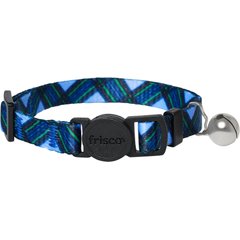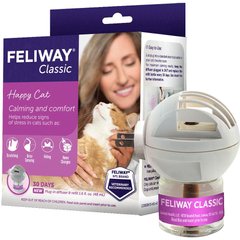How To Keep Your Cat Calm and Safe During Fireworks
iStock/IvanJekic
Many people love celebrating holidays—especially if they involve fireworks. For cats, however, holidays with fireworks can take on an entirely different tone: one of fear and anxiety.
This fear can lead to dangerous situations. A scared cat is more likely to run away from home and get lost, which increases their chances of harm from cars, predators, or illness.
Here’s how you can keep your cat calm during fireworks.
Key Takeaways
- Cat fireworks anxiety can lead to cats running away from home to escape the noise—contributing to a lost pet situation. Make sure your cat is microchipped and their information is up to date.
- There are plenty of ways to help ease your cat's anxiety including providing them with calming supplements or treats, or counter conditioning their reaction to the noise.
- Talk to your vet if none of the below seem to be helping your anxious cat—they can discuss cat anxiety medications that may help.
Are All Cats Scared of Fireworks?
The fear of fireworks is a noise phobia for cats—but not all cats experience it. Some cats will sleep calmly through holidays like New Year’s Eve and the Fourth of July, while others will panic.
If you haven’t yet encountered fireworks with your cat, it’s best to plan for the worst (cat fireworks anxiety) and hope for the best (the usual cat-like ability to sleep through anything).
10 Tips for Keeping Your Cat Calm and Safe During Fireworks
Cats and fireworks are not usually a good combination, so here are some tips for making sure you both stay calm during the next big celebration.
1. Make Sure Your Cat Is Microchipped
Microchips in cats have helped many lost animals return home safely. They are small implants (about the size of a grain of rice) that your veterinarian places under the skin, between the animal’s shoulder blades.
Microchips are inert, meaning they are not active tracking devices that send out signals. However, most veterinarians and shelters have the right equipment to scan cats for microchips. If your cat is microchipped, the person who scans them will be able to access your cat’s information, including your contact information.
It's important to remember that microchips are only as good as the humans who keep the information up to date. Every time you change your address, email, or phone number, make sure to update the microchip’s database. This is usually done through an online portal.
Many people think that because their cat is an indoor cat, there is no need for a microchip. But accidents can happen, and pets can escape out of a loose window screen, burst out of their carrier on the way to the vet clinic, or slip out an open door.
Missing cats can easily lose their collars, but a microchip (and its lifesaving information) remains with them forever.
Along with microchipping your cat, it’s a good idea to have a collar and a tag with your info on it for the best odds that you will be reunited. You can even invest in a cat GPS tracker so you always know where kitty is.
2. Bring Your Cat Indoors
Even if your cat is usually an outdoor cat, bring them inside your home or garage before fireworks begin. You don’t want your cat to be injured by the fireworks or run away and get lost because they were frightened.
Some people who have very young children begin their festivities early so the kids can enjoy them before their bedtime. Aim to have your cat inside by early afternoon on days you expect fireworks.
3. Create Safe Hiding Spots
Hiding is a natural behavior for cats, and being able to get away and hide from something scary reduces the fear and stress fireworks can cause.
Creating a hiding spot can be as simple as placing a cat bed inside a plain cardboard box on its side, or draping a cat blanket over a laundry basket so your cat can burrow in.
Being able to get away and hide from something scary reduces the fear and stress fireworks can cause. You can also play some calming music in this room to help mask some of the noise outside.
4. Seal off Any Unsafe Hiding Spots
While it’s good for cats to have plenty of hiding spaces to choose from, make sure they can’t access any places that aren’t safe, such as under the roof or inside a crawlspace.
If you know your house has these types of hazards, close off those areas for the duration of the fireworks display.
5. Don't Confine Your Cat to a Small Space or Room
You may think that it’s best to keep your cat in one room during fireworks, but this can actually stress them out more. Cats hate to be confined, and being placed in small areas can increase their anxiety and fear.
Allow them access to a few safe rooms in your house so they can move around and choose one or more hiding spots as needed.
6. Give Your Cat Calming Treats or Supplements
Calming treats and supplements can be purchased online and many of these treats contain items such as C3 calming complex, L-theanine, thiamine, chamomile, and other ingredients that may help to reduce stress.
Test out the treats or supplements on a normal day, well in advance of an anticipated fireworks show. Watch for how the supplements affect your cat when they’re already calm and relaxed. This will help you gauge how your cat will react to them in a stressful situation.
You can also consider a pheromone collar. It releases a pheromone similar to the ones produced by mother cats, which can help kitties remain calm and feel safe.
7. Use a Pheromone Diffuser
Cats use the scent glands on either side of their face to mark items and places as safe and familiar, and to mark the boundaries of their territory.
Spraying a synthetic pheromone mist such as Feliway® into a place they like to hide offers a sense of security, provides stability, and reassures a scared cat.
8. Try Aromatherapy
Scents such as catnip have been found to relax cats and increase their sleep time. This is because catnap contains a chemical, nepetalactone, which binds to receptors in cat’s brain—helping them to feel relaxed and happy. They can also sometimes bring out the playfulness in cats.
You can also consider a catnip spray made specifically for cats. To increase the efficacy of aromatherapy, introduce the scents right as the fireworks are beginning. But avoid using essential oils, these can be toxic or cause stomach upset.
9. Use Veterinary-Prescribed Medications
If your cat is still extremely fearful no matter what you do, reach out to your veterinarian to ask for an anxiety medication that can be dosed prior to these stressful events.
Medications such as benzodiazepines, GABA analogs, and selective serotonin reuptake inhibitors (SSRIs) are commonly used in both human and veterinary medicine to reduce anxiety and fear.
10. Train With Counter-Conditioning and Desensitization Techniques
It’s possible to undo a learned behavior (including fear when fireworks are shot off) and replace it with a more relaxed one. However, this type of training needs to be done weeks to months before a scary event occurs.
Try playing a recording of fireworks very softly (so can barely hear it) and give your cat a treat while the fireworks play. Once your cat is comfortable with that noise level, increase it by tiny increments over time—and keep the delicious food and rewards flowing.
If your cat shows signs of fear, such as salivating, panting, pulling their ears back, widening their pupils, or tucking their tail, do not punish or reward your cat. Just drop the volume to a level that’s comfortable for them and start again.
Cats and Fireworks Safety
Aside from the noise, fireworks can be physically dangerous to your cat. Make sure your cat is safely indoors so they do not encounter active fireworks. These can cause serious injury to your cat including severe burns.
Spent fireworks are poisonous to cats if eaten. Hazardous chemicals such as potassium nitrate, chlorate salts, and barium are used to make the beautiful colors.
Fireworks may also contain charcoal or sulfur. If you see your cat eat part of a firework, take them immediately to a veterinarian.
References
Campbell B, Hacker J, Helms T, Steffes Z. Fear of Fireworks. UC Davis Veterinary Medicine; UC Davis Clinical Behavioral Service. [n.d.]
Overall K. Clinical Behavioral Medicine for Small Animals. Mosby. 1997.
Weiss E, Mohan-Gibbons H, Zawistowski S. Animal Behavior for Shelter Veterinarians and Staff. Wiley Blackwell. 2015.








